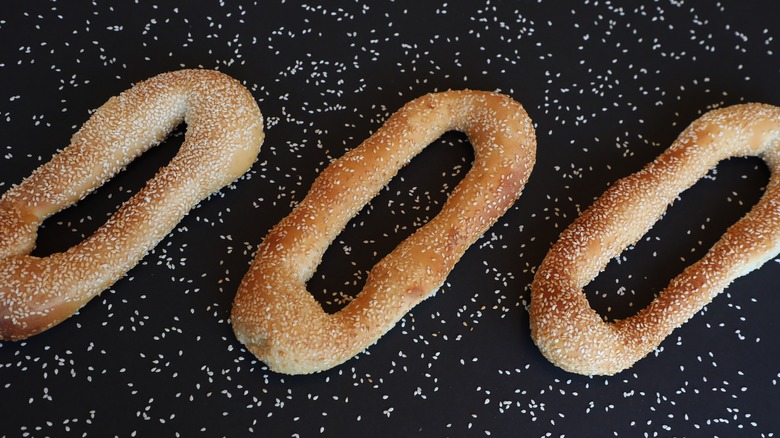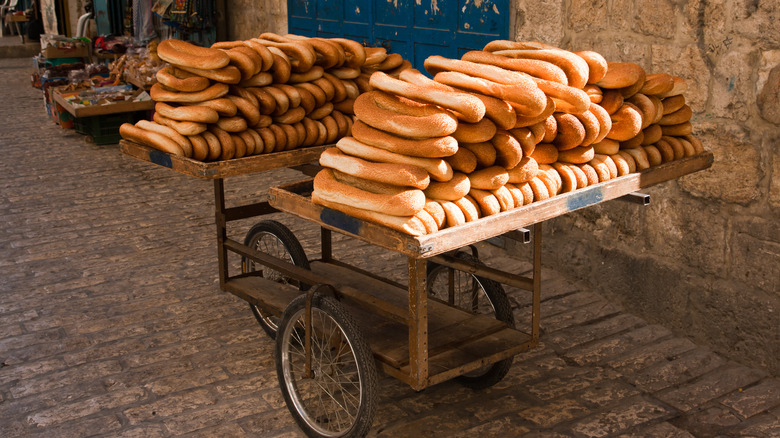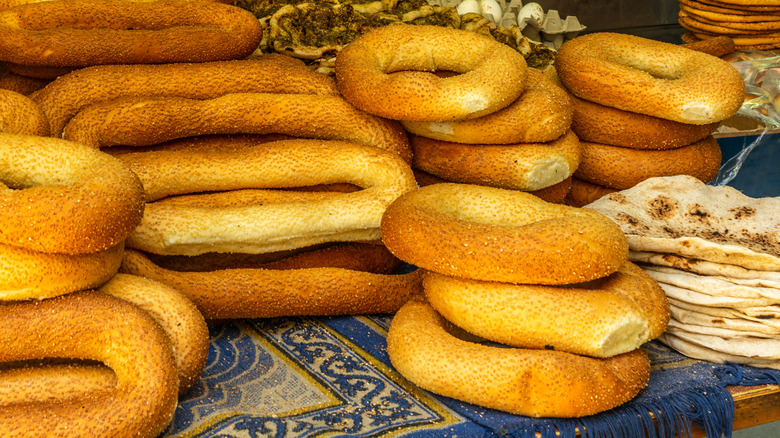Switch To Jerusalem-Style Bagels And You'll Never Look Back
A great bagel is hard to beat when you're craving something chewy, carb-y, and slathered with cream cheese. While many Americans are mostly familiar with New York-style bagels, there are several round-shaped, handheld circles of baked dough around the globe, like Turkish simits and Chinese girde naan. However, it's the Jerusalem bagel that might make you rethink which ring-shaped bread reigns supreme.
Also called ka'ak al Quds, Jerusalem bagels resemble sesame bagels that have been stretched into an oblong oval shape. In the city of Jerusalem, they are a popular street food, sold on street carts and in neighborhood shops. It's common to hear the familiar calls of "kaaaa'aaaaak!" from vendors who load their carts with the fresh-from-the-oven breads, to the delight of hungry people of all ages flocking to get their hands on the warm bagels. You won't find an array of flavors in Jerusalem bagels like you do with New York ones; they tend to come topped with sweetened sesame seeds, making them delicious enough to eat as is, although not many would say no to an accompanying dip either.
These bagels are airy and oval-shaped
The first thing you'll notice about Jerusalem bagels is their shape. They appear almost cartoon-like, as though someone stretched a New York sesame bagel into an oval. Texture-wise, Jerusalem bagels are much less dense than their American counterparts because they are not boiled, resulting in a more airy consistency. Another distinctive feature is their slightly sweet taste, which doesn't necessarily come from the dough itself (although it does contain a bit of sugar), but from the sesame topping.
Sesame seeds are mixed with honey or pomegranate molasses to adhere the seeds to the bagels, imparting sweetness and helping the seeds stick to the dough. Once baked, you get the delicious, nutty flavor of toasted sesame seeds. In Jerusalem, it's not uncommon to see people munching on whole bagels while walking down the street — not sliced and toasted as you might see in Manhattan. However, because they are soft and airy, they can be and often are dipped into olive oil and za'atar or used to scoop up Middle Eastern spreads like hummus and labneh.
For the home baker, Jerusalem bagels are arguably simpler to make than homemade New York-style bagels, since boiling the unbaked dough isn't necessary. If you want to try these delicious bagels, making them on your own might be your best bet, as they are not as widely available fresh in the United States.
Jerusalem bagels have Arabic roots
New York and Jerusalem bagels, not to mention several other types of circular breads around the world, may all have Arabic origins. In a 13th-century Arabic cookbook called "Kitab al Wusla ila al Habib," there is a recipe for a type of ka'ak that essentially involves shaping, boiling, and finally baking the dough, reminiscent of the steps taken to create a bagel. "Ka'aks" are even mentioned in an earlier Arabic cookbook, the 10th-century "Kitab al Tabikh," but no recipe is provided, suggesting that the dish was a common one.
As the Arabs conquered large parts of the Mediterranean region in the Middle Ages, they introduced their recipes to various places. Evidence of this can be seen in tarallo, a ring-shaped bread that is boiled then baked, from Italy's Puglia region. Bona Sforza, born in Bari, the capital of Puglia, who eventually relocated to and became Queen of Poland, may have initially brought the idea of the bagel there with her. Other similar breads (like the aforementioned simit and girde naan) have similar histories, essentially rooting them in Arab culture.
Enjoy Jerusalem bagels any time of the day; you can even treat them like New York bagels and cover them with scallion cream cheese and lox. After all, we like to think there's no wrong way to eat any bagel, no matter where it's from.



